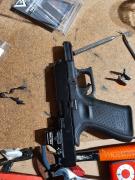I can only relate to how this applies to competitive shooting, but with good shot calling you can make the decision to shoot or no shoot or shoot again in real time based on vision.
On this clip the second target I didn’t like the shot so I took a make up in real time.
On the second to last target I went back to it to take another shot.
The better mechanics you have the more mental bandwidth you have to process things quicker.
Also @1Rangemaster they are absolutely NOT bursts. Even going at full speed I am calling each shot and you see this demonstrated better when we get to swingers and Texas stars.
This is “slow” vision:
Also the vast majority of USPSA are pairs (both aimed even if fast) or single shots (steel). Bursts aren’t even part of the genre for practical shooting for the most part.
Think of it this way:
The better and faster your index, the higher likelihood your target is still in the same place when you pull the trigger.
For people that take an eternity to get the first shot off, the target likely isn’t still in that place or position which is why it’s important to have a good index.
I think using a P938 SAS on a close Texas Star illustrates what I’m talking about. You can see the muzzle tracking the movement of the swinger and the shots come when on target. Moving faster on a transition for the last plate, it doesn’t have a chance to move off of position.
For moving targets, we “lead” the target like sporting clays. If you can’t engage rapidly enough or transition rapidly enough, you can’t do a proper lead for any reasonable speed target.




 Reply With Quote
Reply With Quote

